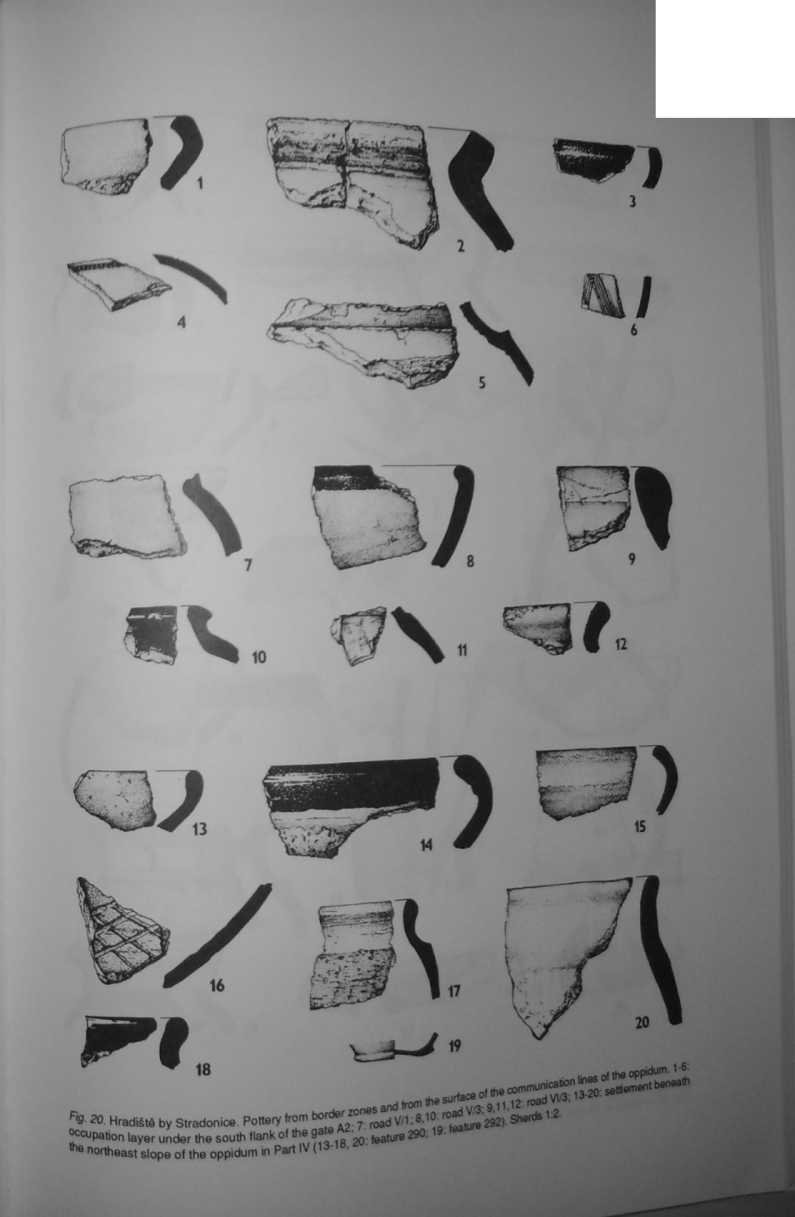S5002127
82
VI. Survey of the finds and their contribution to our knowledge of the economic basis of the oppidum
Evaluation of the finds is to a certam ex ten t limited by the fact that the excavations performed at the oppidum I of Stradonice between 1981-84 were of a rescue naturę. The gas trench as well as other building acthrities damaged the identified features to varying degrees. Their remains, preserved in the sectlons, yielded almosl exclusively samples of finds. In some cases, time allowed the partial investigation of the ground piana of features (features 1,22,23,57,64,85,116,148,259a). However, the assemblage of varlous artefacts gainod by sampling the fills of settlement features generally represented the products of everyday actlvlties carried out by the inhabitants at the oppidum. Although they only occurred in minor quantities, they generally appeared to correspond with the variety of Items published by J. L Pić. Lux ury and imported Items were only represented exeptionally. Many artifacts were found whlch are common at other oppida in central Europę, therafore not all analogies are described, with the exception of those cases where it helped to determine their function. I The primary significance of the Stradonice assemblage lies in the fact that the artefacts are stratified within I known find circumstances. Certain conclusions can therafore be madę on the basis of their relative I chronological position and spatial occurrence.
1. Pottery
Pottery sherds can be, in view of the excavation method utilised, only assessed as a complex containing all samples obtained from the settlement features recorded between 1981 -84. The comparatively large number of sherds (2696 fragments) allowed the determination of indlviduai pottery types, a total of eight categories being distinguished.
Calegory A is represented by 108 sherds of painted pottery (4.01 %). Category B includes fme pottery, also wheel-made, with a brown to grey polished surface (622 sherds), representing about a quarter of the total assemblage (23.07%). Combed wara, mostty wheel-made, classified as category C (194 sherds), was present in comparatively Iow amounts (7.20 %). Pottery for daily use (1772 sherds) represents the largest proportion of the assemblage (65.73 %). This could be subdivided into five different categories D-H. Vessels madę from crude day with a minerał admixture prevail, being classified as category E (1356 sherds; 50.30 %). According to the regular shaping of their upper parts, this pottery type was hand-made with wheel-finished rims. This is also true for category G, which consisted of coarse pottery with a high mica admbcture, represented by 21 sherds in the assemblage (0.77 %). The following two pottery types, utilised for daily activities, represent other significant components. Prinapally, category D, represented by wheel-made pottery forms for daily use, madę from grey, hard baked, fine-grained day, amounting to morę than 10 % within the assemblage (296 sherds, 10.98 %). Category H (83 sherds, 3.08 %) consisted of comparatively thick-walled forms of pottery for daily use, which were wheel-made from fine day. Coarse, irregular, hand-made forms of pottery, classified as category F (16 sherds, 0.60 %) occur sporadically within the assemblage.
Within each of the eight categories A-H several basie forms could be distinguished on the basis of the profile of their upper parts. These are presented In Plates 10-16. Within some of the form types, particularly the numerous group of pottery utilised for daily acthrities (categories D-H), several different variants could be dassified, espedaUy in the case of pots and bowls where their main charaderistic was provided by the shape of their neck or rim. A large group of pottery fragments, however, was represented by body sherds which could not be predsely determined. Despite this, they were included into the survey not only in the case of decorated sherds (colour and/or pattern of painted pottery, form of combing in combed wara) but in order to provide evidence of the extension of specific categories of pottery within various parts of the oppidum. Only body sherds of the most common pottery type, i.e. category E, were excluded from the survey, sińce they were represented in all settlement features, and their quantification is given in the catalogue.
The collectkm of pottery obtained by sampling the settlement features dui«g the 1981-84 rescue excavations at Stradonice does not represent the entire variety of localiy produced or imported wares at the oppidum. Painted pottery is undoubtedly underrepresented, sińce its uariety of shapes and decorative eiements are distinctly broader amongst the unstratified older finds (cf. Bfeń 1973a, 108-117, Plates IV-IX). Similarty, the group of fine pottery within our assemblage can be assumed to have been morę varied. łt could

Wyszukiwarka
Podobne podstrony:
Solon Jerzy: "Smali habitats" and their input to flora and vegetation diversity on the lan
257 contributions that have added to our knowledge of the area, one of tlie most recent is his editi
NOKIA GSM ArchitectureFigurę 2. The three subsystems of GSM and their interfaces The NMS is the oper
2.1 Introduction This chapter will give you a brief orientation of the nodes and their functions in
280 (54) Survey of numerical methods and algorithms. Part 2Summary Thisbook is the second part of a
shall pay their annual contributions to the International So-ciety. The amount and the datę of payme
60 Zuzanna Wiorogórska tools and their use”. These actions allowed limiting the number of categories
Suzuki RM125? 6-14 CYLINDER, PISTON AND EXH AUST VALVE • Inspect the balls and the
242 Stanisław Wilk Matoga conducted a surface survey in the village of Książnice and started the
Ali of tlie import ant facets of the story— die character development and their interactions, meanin
więcej podobnych podstron